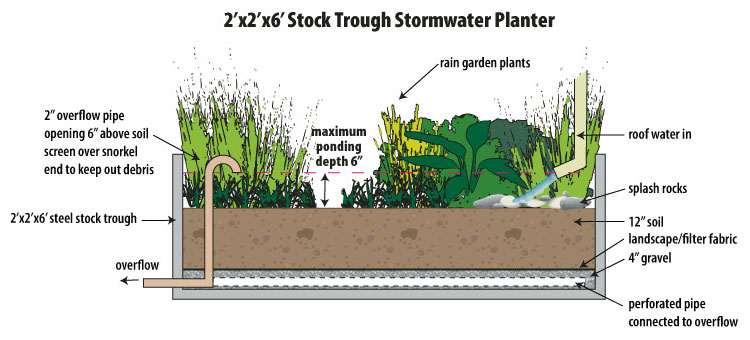
A stormwater planter is an easy and attractive way to manage and filter some of the rainwater coming off a roof or other impervious surface. Managing this water helps protects our urban streams and infrastructure, and reduces the load on them. Rainwater runoff enters the planter and is filtered through a layer of mulch, soil and sand before it overflows onto your lawn, landscaping, or into a rain garden. The water-loving rushes and sedges in the planter also absorb a lot of the water.
In a large rain storm, the planter is designed to overflow out of the overflow pipe. To ensure the treated water coming from the planter doesn’t damage the house foundation or overflow onto a neighbor’s property, the overflow outlet should be located a safe distance from property lines and house foundations.
The overflow outlet should be:
- a minimum of 10 feet from a house with a basement
- at least 2 ft from a house with a crawl space or slab foundation
- at least 5 ft from any property line
- at least 3 feet from a public sidewalk
Permits:
Check with your local jurisdiction to determine whether you need a permit to disconnect your downspout and direct it to a stormwater planter.
Maintenance:
Once the stormwater planter is built and set up, it will generally not require much maintenance! Runoff from the roof will provide water the plants need for much of the year. Here are two things you can do to keep your plants in good health, and able to absorb the most stormwater.
- weed and mulch the planter as you would any landscaped area
- water the plants during dry summer months
Planter Design: Notes, and a sample diagram with technical specifications
The diagram below is just one of many potential designs! Many factors should be considered when selecting a design or coming up with your own, such as the roof area the downspout covers. It is recommended that a plastic liner be used to line the trough before other components are installed. A standard 3-4″ perforated pipe should provide sufficient drainage.
Ideal Native Plants for a Stormwater Planter
Stormwater Planter – Plant List Latin name – Common name |
| Evergreen Groundcovers |
| Carex densa – Dense sedge |
| Carex stipata – Sawbeak sedge |
| Carex obnupta – Slough sedge |
| Deschampsia cespitosa – Tufted hairgrass |
| Juncus patens – Spreading rush |
| Flowering Accent Plants |
| Camassia quamash – Common camas |
| Mimulus cardinalis – Monkey Flower |
| Lupinus polyphylus – Large-leaved Lupine |
| Lupinus rivularis – Stream Lupine |
| Source: City of Portland, Vegetated Stormwater Facilities in the Public Right of Way, 2007 |
Design your own stormwater planter!
If you have questions on where to find designs, or whether a stormwater planter would work in your yard, email Whitney Bailey or call at (503) 935-5366.

